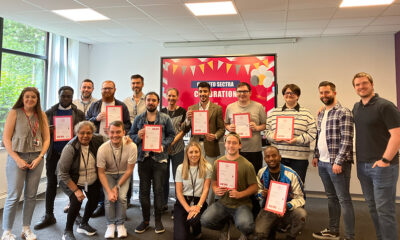Lifestyle
How to use the “12-week year” to boost your productivity

The “12 Week Year” created by Brian P. Moran and Michael Lennington summarizes annual goals in 12-week periods. This method is designed to increase urgency and clarity, helping you get more done in less time.
Traditional annual goals often lead to postponement because the December deadlines are so far in the future. However, the “12 week year” keeps you constantly engaged by shortening the cycle.
This article explains how to use the ’12 Week Year’ approach to increase your productivity by transforming both your personal and professional goals with focused execution in each quarter.
Understanding the ‘year of twelve weeks’
The “12 Week Year” is a method designed to accelerate your success by changing the way you think about time. Instead of a typical annual review, this approach divides your year into four quarters, each consisting of twelve weeks.
This creates shorter execution cycles, which are crucial for increasing productivity and achieving results faster.
Core principles
The “12 Week Year” is built on three important pillars:
- Urgency: The shortened time frame creates a sense of urgency. Without the luxury of procrastination, you are forced to act more decisively and consistently.
- Brightness: Setting goals for just 12 weeks ensures you are specific about what you want to achieve. This clarity simplifies decision-making and focuses your efforts on what really matters to your goal.
- Feedback: Fast cycles provide faster feedback on your strategies and results. This frequent reassessment helps you stay aligned with your goals and quickly make necessary adjustments.
Advantages over traditional planning
Switching to a 12-week cycle offers several advantages compared to an annual plan:
- Increased productivity: Because the end is always in sight, you are more likely to stay energetic.
- Better focus: Shorter cycles mean less time for distractions, so you can focus on the tasks that move the needle.
- Faster performance: You can experience the satisfaction of achieving goals and leveraging those successes to drive further achievement within the same year.
Plan your 12-week year
This section will guide you in creating a plan that is not only actionable, but also aligned with your goals.
Step-by-step planning process
- Define clear objectives: Start by figuring out what you want to achieve at the end of the 12 weeks. Your goals should be specific, measurable, achievable, relevant and time-bound (SMART).
- Divide the most important goals into tasks: Break each goal into smaller, manageable tasks that can be completed weekly or even daily. This breakdown makes the goal less daunting and easier to manage.
- Prioritize tasks: Order your tasks by priority, focusing first on the tasks that will have the greatest impact on your goals.
- Assign deadlines and milestones: Set deadlines for each task and set milestones so you can assess and celebrate your progress.
“Productivity is never an accident. It is always the result of a commitment to excellence, intelligent planning and focused effort.” –Paul J. Meyer
Example: opening a new tattoo studio
Suppose you are an entrepreneur and want to open a physical store, such as a tattoo studio, within twelve weeks. Here’s an example of what you might want to do each week:
- Week 1: Conduct market research and develop a business plan.
- Week 2: Conduct surveys to understand customer demand and finalize financial projections.
- Week 3: Find potential store locations.
- Week 4: Negotiate and sign a lease for your studio space.
- Week 5: Plan the layout of your studio and hire contractors for any plumbing, electrical, etc. problems.
- Week 6: Start renovations.
- Week 7: Prepare all licensing and legal compliance paperwork.
- Week 8: Get your business licenses and schedule a health inspection with the local health department.
- Week 9: Interview and hire tattoo artists and someone for the reception.
- Week 10: Develop and execute a marketing plan.
- Week 11: Prepare for your grand opening and generate buzz with ads and social media posts.
- Week 12: Host a grand opening event on Flash Day.
Then, further break each of these weekly goals into small steps so you know what to do every day of the week to achieve that week’s goal.
By breaking down the goal into these detailed, time-specific tasks, you can manage each step effectively, making the daunting task of opening a new studio seem more doable.
Tracking progress, accountability and learning from each cycle
Reviewing progress regularly (daily, weekly and at the end of each twelve-week period) will ensure you stay on track and can make changes to your plan if necessary. Using progress charts or digital trackers can also make it easier to stay motivated while working at a fast pace.
Having an accountability partner or joining a peer group can also help keep your motivation high.
If you are doing a “12 week year” multiple times, it is important to review each “year” when you are done. That way you can find out what worked and what didn’t, and how you can improve it in the future.
By learning from each cycle, you can continually make improvements so that each twelve-week period is more productive than the last.
Final thoughts
The ’12-week year’ transforms traditional goal setting by dividing the year into intensive 12-week cycles to increase focus, urgency and productivity. Each cycle encourages continuous growth, allowing for quick adjustments and immediate results.
Use this strategy to be as productive as possible so you can take big steps forward every quarter and make real progress toward your goals.













